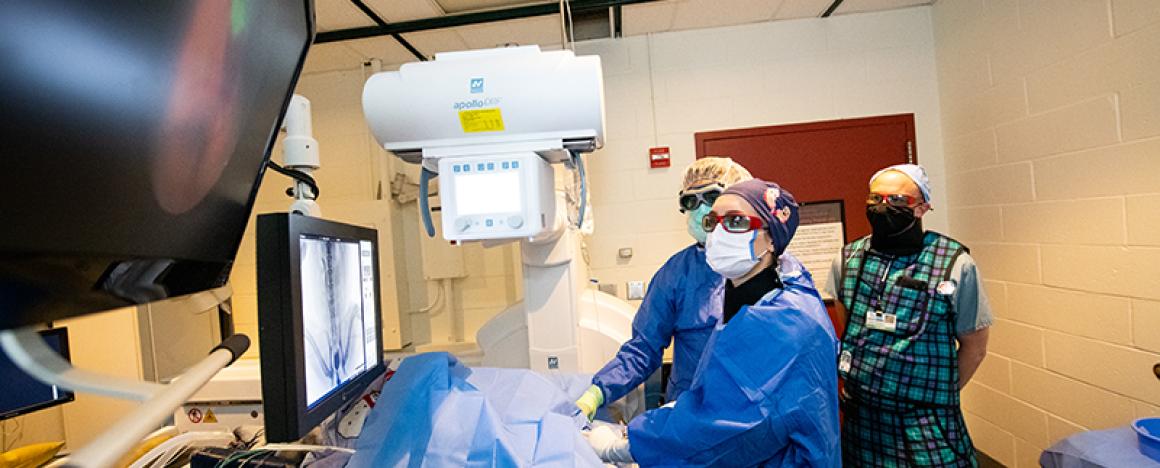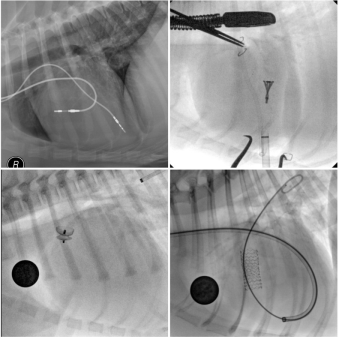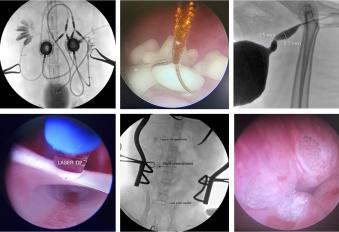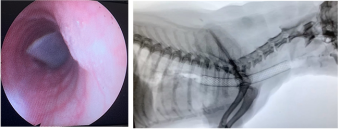Interventional Radiology & Endoscopy (IR/IE)

Referring Veterinarians
Referring a client to Foster Hospital is easy with veterinarian liaison support.
Cardiovascular
The Tufts Cardiology Service specializes in minimally invasive treatment of various types of congenital heart disease, acquired mitral valve disease, and intrahepatic portosystemic shunts. Minimally invasive interventional procedures typically involve using a catheter inserted through a peripheral blood vessel to access cardiac or vascular structures. For myxomatous mitral valve disease, a hybrid approach is utilized to allow trans-catheter access to the mitral valve through the left ventricular apex. Dogs and cats typically recover rapidly from both minimally invasive and hybrid interventional procedures, with little evidence of post operative discomfort.
Conditions we treat:
- Patent ductus arteriosus (PDA)
- Pulmonary valve stenosis (PS)
- Bradyarrhythmias (atrioventricular block, sick sinus syndrome, atrial standstill)
- Myxomatous (degenerative) mitral valve disease (MMVD) (select cases only)
- Intrahepatic portosystemic shunts (IHPSS)
- Cor triatriatum sinister, cor triatriatum dexter
- Caval syndrome
- Subaortic/aortic stenosis (SAS) (select cases only)
- Other complex congenital heart disease
Procedures we offer:
- ACDO, vascular plug, or coil occlusion of patent ductus arteriosus
- Balloon valvuloplasty for pulmonary stenosis and for select cases of subaortic/aortic stenosis
- Transpulmonary stent implantation
- Transvenous pacemaker placement
- Trans-catheter edge-to-edge repair (TEER) with the V-clamp device
- Stent and coil attenuation for intrahepatic portosystemic shunts
- Hybrid balloon dilation of cor triatriatum sinister
- Heartworm extraction
Endourology
Interventional radiology and endoscopy (IR/IE) uses fluoroscopy and cystoscopy to get access to the different structures of the urinary tract for diagnostic and therapeutic purposes. These state-of-the-art techniques avoid more invasive surgical techniques.
Conditions we treat:
- Bladder stones
- Ectopic ureters and other urogenital abnormalities
- Ureteral obstruction (stones, stricture, mucus/pus plug, tumor)
- Urethral obstruction (stone, stricture, tumor)
- Refractory incontinence
- Renal hematuria
Procedure we offer:
- Advanced imaging of urinary tract (fluoroscopy, cystoscopy)
- Percutaneous cystolithotomy (PCCL)
- Laser ablation of ectopic ureters
- Laser ablation of vestibulo-vaginal septum remnant
- Perineal approach (for male cystoscopy)
- Subcutaneous ureteral bypass (SUB)
- Ureteral stenting
- Urethral stenting
- Injectable bulking agent for treatment of urinary incontinence
- Artificial urethral sphincter for treatment of urinary incontinence
- Renal sclerotherapy
Respiratory
Conditions we treat:
- Tracheal collapse
- Nasopharyngeal stenosis
- Tracheobronchial foreign body
- Tracheal mass
Procedure we offer:
- Advanced imaging of respiratory tract (laryngo-tracheo-bronchoscopy, fluoroscopy, CT-Scan)
- Intra-luminal tracheal stent
- Tracheobronchial foreign body removal
- Tracheal mass removal
- Nasopharyngeal stenosis dilation







